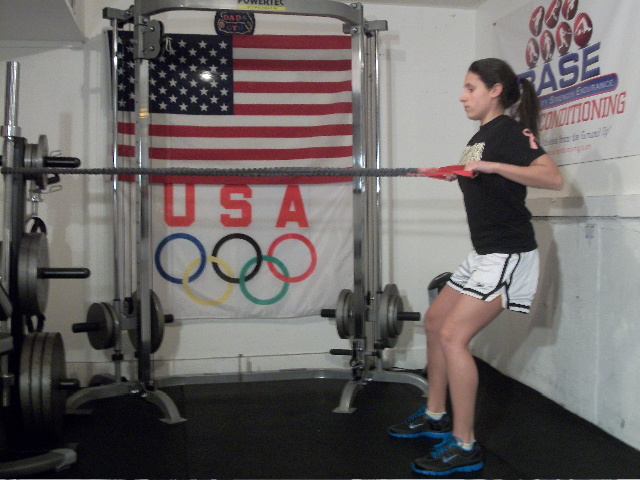Thinking about starting your child or teen in a resistance training program, but wondering whether it is a good idea?
The answer is that, not only should parents have no cause for concern, but, according to a new international consensus statement (Loyd RS, et al 2014), resistance training for children and adolescents has a number of signfiicant benefits, including improved athletic performance, preventing injuries, and a positive effect on overall health.
There is a "compelling body of scientific evidence," says the statement, that supports regular participation in youth resistance training to reinforce positive health and fitness adaptations and sports performance enhancement. Support is even stronger, says the experts, for the use of resistance training in youth, provided such programs are supervised by qualified professionals and consistent with the needs, goals and abilities of children and adolescents.
Most opportune time
Research clearly indicates, the statement says, that appropriately designed resistance training programs can benefit youth of all ages, with children as young as 5-6 years of age making noticeable improvements in muscular fitness following exposure to basis resistance training using free weights, elastic resistance bands and machine weights.
"It is noteworthy that traditional fears and misinformed concerns that resistance training would be harmful to the developing skeleton [and stunt growth or reduce eventual height in adulthood] have been replaced by reports indicating that childhood may be the opportune time to build bone mass and enhance bone structure by participating in weight-bearing physical activities," writes Dr. Gregory Meyer, a sports medicine physician at Cincinnati Children's Hospital, and one of the statement's co-authors.
In fact, writes Dr. Meyer, not only are fears that resistance training would injure the growth plates of youths not supported by scientific reports or clinical observations, studies show that childhood and adolescence are indeed key developmental periods for increasing bone-mineral density, and that failure to participate in moderate-to-vigorous weight-bearing physical activity during these stages of growth may predispose youth to long-term bone-health implciations.

Improves athletic performance
Research has indicated that various forms of resistance training can help significantly improve athletic performance by improving:
- muscular strength
- gains in maximum strength have ranged from approximately 10% to 90%, depending on several factors, including the volume, intensity, frequency, duration, and design of the training program, as well as the quality of the supervision);
- in general, expected strength gains of 30-40% are typically observed in untrained youth following participation in an introductory (8 to 20 weeks) resistance training program.
- power production;
- running velocity;
- change-of-direction speed; and
- general motor performance.
A recent literature review (e.g. meta-analysis) found that resistence training is effective in enhancing motor skill performance (jumping, running, and throwing tasks), and that children showed greater gains in performance than adolescents, underscoring, the statement says, the importance of implementing progressive training programs early in life when children possess higher levels of neural plasticity.
Improves general health
From a health perspective, the evidence indicates that resistance training can:
- make positive alterations in overall body composition,
- reduce body fat
- improve insulin-sensitivity in adolescents who are overweight and
- enhance cardiac function in children who are obese.
Importantly, it has also been demonstrated that regular participation in an appropriately designed exercise program, inclusive of resistance training, can enhance bone-mineral density and improve skeletal health.
Psychosocial benefits
Less clear is whether resistance training can lead to improvements in psychological well-being. The research in this area is limited, and what little there is has produced mixed findings, with a small number of studies failing to demonstrate significant resistance-training induced psychological benefits, and other research suggesting that physical activity programs, including resistance training, can lead to improvements in  psychological well-being, mood, and self-esteem, especially for youth who possess relatively low levels of self-concept at the start of an exercise program.
psychological well-being, mood, and self-esteem, especially for youth who possess relatively low levels of self-concept at the start of an exercise program.
On the other side of the coin, however, it should be noted that excessive physical training (inclusive of resistance training) can lead to negative psycho-social effects, especially for youth who are emotionally and pschological vulnerable. "Excessive training with inadequate recovery," the statement says, "may lead to a child or adolescent experiencing overtraining syndrome" and can have "serious psychosocial consequences, ... highlight[ing] the need for appropriate prescription and supervision by qualified professionals who listen to individual concerns and understand the physical and psychological uniqueness of younger populations."
Injury prevention benefits
Although the total elimination of sport-related and physical-activity related injuries is an unrealistic goal, multi-faceted training programs that include general and specific strength and conditioning activities may help to reduce the likelihood of youth sports injuries.
The statement points to studies showing that:
- incorporating resistance training into preseason conditioning for adolescent American football players resulted in a reduction in both minor knee injuries and those requiring surgery over four seasons;
- adolescent athletes who followed a resistance training program suffered fewer injuries and recovered from injuries with less time spent in rehabilitation compared to teammates who did not participate in a similar resistance training program;
- implementation of a comprehensive warm-up program that incorporated resistance-based exercises successfully reduced the risk of severe and overuse injuries in female adolescent soccer players;
- adherence of adolescent female soccer players to an injury prevention program is greater where facilitated by appropriately trained coaches;
- resistance training focused on the risk factors associated with youth sports injuries (e.g. low fitness level, muscle imbalances and errors in training) has the potential to reduce overuse injuries by approximately 50% in children and teens; and
- the effectiveness of injury prevention programs is greater if implemented in younger age groups prior to the onset of neuromuscular deficits and the development of poor biomechanics.
For youth who participate in multiple sports or multiple leagues with the same sport, the statement recommends resistance training, not simply as a addition to the athlete's sports schedule but as a compulsory component in lieu of additional competitive events or sport-specific training sessions.
Year-round training recommended
Evidence indicates that the most effective training programs last more than 8 weeks and involve multiple sets, and that generally strength gains increase with the frequency of training sessions per week.
Following a short training program, detraining is quite rapid. As a result, the statement recommends that youth be encouraged to participate in year-round resistance training in order to maintain training gains in muscular strength.
Particularly beneficial for young female athletes
A resistance training program, while beneficial for all children and teens, is particularly important for young adolescent girls, says the statement.
Musculoskelatal growth during puberty, in the absence of corresponding neuromuscular adaptation, says the statement, may facilitate the development of abnormal joint mechanics and injury risk factors, including abnormal biomechanics such as increased knee valgus (e.g. knock knees) movement when landing. If not addressed, such risk factors may continue to develop throughout adolescence, the statement says, predisposing female athletes to increased risk of injuries. 
Early participation by female athletes in a multifaceted resistence training program, says the statement, can:
- result in safer movement mechanics and increased posterior chain strength (e,g, glutes, hamstrings, and lower back which are considered to be the most influential muscle group for athletes as they are prime movers of forward propulsion);
- reduce the incidence of ACL injuries;
- help those with low-motor competence catch up with their peers in terms of neuromuscular control;
- induce natural increases in muscle power, strength, and coordination (the so-called "neuromuscular spurt") that occurs with increasing age in adolescent boys but is not typically seen in females; and
- if timed with growth and development induce the neuromuscular spurt, which may improve sports performance and improve biomechanics related to injury risk in young females.
Recommended by WHO
The World Health Organization (WHO) now recognizes physical activity as the fourth leading risk factor for global mortality for non-communicable diseases. As a result, the organization, along with other public health agencies, now includes resistance training as part of their physical activity guidelines for children and adolescents.
However, recent evidence indicates that the muscular strength levels of school-age youth are decreasing. Progressive resistance training under the supervision of qualified professionals can offer a safe, effective and worthwhile method for reversing this trend, while encouraging participation in resistance training as an ongoing lifestyle choice. The importance of effective education by qualified professionals is essential, as positive early experiences in physical education have been associated with lifelong physical activity.
Statement widely endorsed
The consensus statement has been endorsed by the following groups:
- American Academy of Pediatrics (AAP);
- American Alliance for Health, Physical Education, Recreation and Dance (AAHPERD);
- American Medical Society for Sports Medicine (AMSSM);
- British Association of Sports Rehabilitators and Trainers (BASRaT);
- International Federation of Sports Medicine (FIMS);
- Faculty of Sport and Exercise Medicine UK (FSEM);
- North American Society for Pediatric Exercise Medicine (NASPEM);
- National Athletic Trainers' Association (NATA);
- Brian Hainline, Chief Medical Officer, National Collegiate Athletic Associaiton (NCAA); and
- National Strength and Conditioning Association (NSCA)
Source: Loyd RS, Faigenbaum AD, Stone MH, et al. Position statement on youth resistance training: the 2014 International Consensus. Br J Sports Med 2014;48:498-505. doi:10.1136/bjsports-2013-092952








